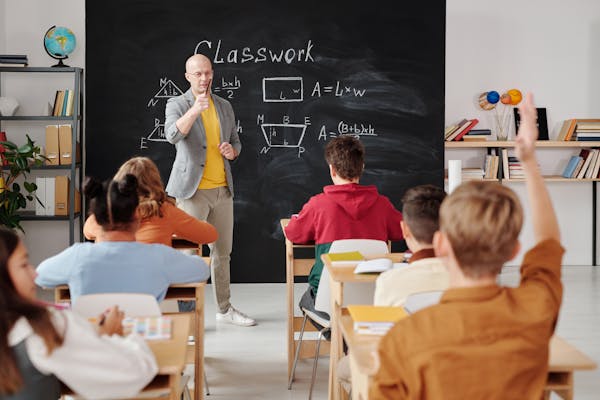It’s crucial to understand where and how to locate the greatest materials for children because learning is an enjoyable journey. Children’s learning styles also vary as the world does. There are a ton of resources and technologies available today that can assist children in learning critical skills in an entertaining and interesting way. The correct materials, such as instructional games and internet platforms, can significantly impact a child’s educational journey.
The Significance of Educational Resources for Children
Learning resources are vital instruments that support children’s curiosity, skill development, and knowledge acquisition. These materials might be digital, such as websites and instructional apps, or palpable, such as books and toys. The objective is to increase learning effectiveness and enjoyment, regardless of the format.
It’s critical to keep in attention that children learn best when they are actively involved. Finding educational materials that are appropriate for a child’s interests and learning style is so vital. While some children might prefer interactive games or films, others could choose to read books.
Websites for Education
Children can benefit much from instructional websites in the current digital era. Many websites provide free interactive exercises, lessons, and games that can improve kids’ educational experiences. Children can admission useful content at home or even while they’re on the road from websites like Khan Academy, National Geographic Kids, and PBS Kids.
Numerous topics are covered on these websites, such as science, math, literature, geography, and history. In order to keep children interested, they also provide films, tests, then challenges that house various learning styles. Websites like ABCmouse, for instance, are ideal for younger kids, but BrainPOP, which provides interactive movies and tests on a variety of topics, may be more appealing to older kids.
Apps for Education
Another excellent resource for education is mobile apps. With the growing popularity of smartphones and tablets, educational applications provide fun and educational experience for children. Children rise apps like Boundless Alphabet, Prodigy Math Game, and Duolingo (for language instruction).
Apps have the benefit of being nearby at any time and from any location. These apps may turn learning into game during lengthy car rides or unhurried afternoons at home. Children can finish challenges and tasks that are both enjoyable and instructive when gamified lessons are used.
Communicating Educational Resources
For children, interactive learning resources like toys, board games, and puzzles provide a hands-on learning experience. With the help of these resources, kids can solve challenges and develop critical thinking skills. Children can construct, experiment, and learn while cultivating an interest in STEM (science, technology, engineering, and mathematics) toys, for instance.

Documentaries and Videos
Children can also learn about diversity of subjects by watching documentaries and movies. A vast array of videos and documentaries covering large range of subjects may be found on websites like YouTube, Netflix, and even educational networks like National Geographic. These films offer both graphic and aural learning, which recovers children’s memory retention.
For those who learn best visually, videos are very helpful. For instance, TED-Ed provides lively movies on a range of subjects, such as history and science, to help kids comprehend difficult concepts in an friendly way.
How to Pick the Best Instructive Materials for Your Child
Children’s hobbies, learning favorites, and age group all play role cutting-edge choosing the best instructive materials. Here are some useful pointers:
Age-appropriate resources: Verify that the materials remain appropriate for the age and developing stage of your child. While older kids might prefer interactive internet and applications, younger kids might benefit from bright books and easy games.
Variety: To keep studying engaging, combine a variety of resources. For instance, to keep things interesting and novel, mix games, novels, and websites.
Pay attention to your child’s interests: When learning gratified is related to something they are interested in, children are more likely to remain attentive. Look for games, movies, and books that teach about primeval animals if your youngster has a captivation with dinosaurs.
Interactive and captivating: Resources that promote involvement are consistently more successful. Seek out resources that encourage creativity, problem-solving, or physical exercise.
FAQS
1. Which resources are most effective for children who have reading difficulties?
Think about audiobooks or e-books with read-along capabilities if your child has reading difficulties. While apps like Epic! have a vast book library with a listening option, websites like Storynory provide free audio stories. Their understanding and reading abilities can be enhanced with the use of these materials.
2. Are websites that offer education free?
Indeed, a lot of educational websites make their content available for free. For instance, PBS Kids and Khan Academy offer free games, movies, and courses. Some apps and websites, though, might offer extra features or subscriptions.

3.How can I assistance my child enjoy learning?
Use variety of communicating resources, such as games, puzzles, and educational applications, to make learning enjoyable. Set learning objectives that will reward your child as they make progress and encourage them to investigate subjects they are interested in. Use practical exercises that need critical thinking and creativity.
4. Can I trust kid-friendly websites?
Selecting reliable and trustworthy websites and platforms is crucial. Websites with realistic and age-appropriate content include Brain POP, PBS Kids, and National Geographic Kids. Before letting your child explore something on their own, always go over it with them.
In conclusion
In summary, children’s learning experiences are greatly aided by the vast variety of educational resources that are currently accessible. These resources support children’s curiosity and knowledge while engaging them by accommodating different learning styles and interests. Interactive websites, mobile apps, instructional toys, documentaries, and games—whether digital or physical—all help to make learning fun and efficient. Children can explore new topics and acquire critical thinking abilities when age-appropriate and varied resources are chosen to keep them engaged and challenged. Parents and teachers may cultivate a lifelong love of learning in their children by selecting materials that align with their individual interests and learning styles.


👍🏼👍🏼👍🏼